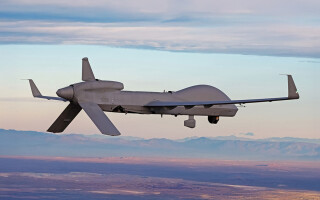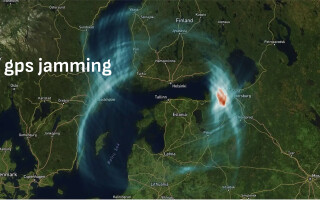Speed, modularity, and more: Satellite communications and space exploration
StoryJune 11, 2025

Meeting the insatiable demand for high-bandwidth, reliable data transmission is a major imperative for applications involving satellites and space exploration where uninterrupted communication is paramount. According to a 2024 study from Research and Markets, the rapid rise in space exploration, combined with the increasing frequency of satellite launches, is ramping requirements for radiation-hardened (rad-hard) electronics that can withstand cosmic radiation and solar flares. As a result, the global rad-hard electronics market is expected to reach $9.77 billion by 2034. This growth is driven by private and government entities embracing highly rugged and reliable solutions capable of enduring extreme ionizing radiation exposure while optimizing stringent size, weight and power (SWaP) requirements.
The U.S. Department of Defense (DoD) relies heavily on satellites, with proliferation considered a top priority of the Space Development Agency (SDA). With responsibility for managing the development and deployment of the Proliferated Warfighter Space Architecture, the SDA is planning to deploy hundreds of optically interconnected satellites to collect and transfer mission-critical data via transport, tracking, custody, deterrence, navigation, battle management, and support layers.
In late March 2025, SpaceWERX, the innovation arm of the U.S. Space Force, announced plans to create multiple maneuverable space vehicles for increasing the speed and flexibility of in-space operations. The development of an “orbital carrier” is designed to serve as a prepositioned satellite launch pad in space to enhance the nation’s space defense by enabling on-demand space vehicle and satellite deployments. These priorities are closely aligned with the need to transfer data accumulated from spacecraft payloads – including sensors, instruments, and technologies – to other spacecraft modules for on-board processing and analysis before sending results to the ground.
A high-speed balancing act
Ongoing technological improvements in avionics modules and spacecraft payloads are generating ever-increasing amounts of high-resolution data that requires high-bandwidth cables to carry data signals between modules. To keep pace with rising data rates, spacecraft designers are deploying higher-speed communication links, including alternatives to traditional copper coaxial cables. Designing and developing rad-hard interconnects is a balancing act, as they must accommodate ever-increasing bandwidth while withstanding prolonged exposure to extreme environmental, electrical, mechanical and thermal stressors.
For starters, the electronics to support faster transmission speeds must be more impervious to radiation exposure. Over time, ionizing radiation, which is measured by total ionizing dose (TID), can degrade the performance of components, rendering them inoperable. Additionally, single-event effects (SEE) caused by interaction with high-energy particles can result in electronic disturbances, ranging from intermittent errors and voltage disruptions to catastrophic device failures.
Choosing fiber-optic cables over copper delivers much faster speeds over longer distances without signal degradation. Unlike coaxial cables, fiber-optic cables are immune to electromagnetic interference (EMI) because they rely on the transmission of light rather than electric signals, and light is not affected by EMI. Using fiber, however, introduces new operational challenges as traditional fiber interconnects must be spliced, polished, and terminated precisely to avoid risk of exposure to foreign object debris (FOD) and cable damage leading to intermittent or complete link failure. Moreover, stringent cleaning and inspection of fiber-optic interconnects is required to avoid contaminated connections, which remain one of the most prevalent causes for fiber-related performance problems in data centers.
Fortunately, a subset of fiber-optic cable solutions, called active optical cable (AOC), alleviates these concerns by blending the benefits of copper and fiber-optic cable assemblies into an integrated interconnect assembly. AOCs are already popular and proven in data centers for connecting servers and networking equipment when distance requirements exceed the limitations of copper cables. Now, next-generation, space-rated AOCs are emerging to provide game-changing advantages for the aerospace and defense market. This enabling technology not only delivers high-speed, high-capacity (“big pipe”) transmission, it also offers product designers much-needed design flexibility, modularity and versatility.
How AOCs work
Unlike conventional fiber-optic cables, which consist of fibers terminated by optical connectors, AOCs are an optical fiber cable with electrical connectors at each end. They accept the same electrical inputs as traditional copper cables but use optical fiber between the connectors for increased cable speed and distance without sacrificing compatibility with standard electrical interfaces.
As depicted in Figure 1, an electrical signal on the transmit side of an AOC goes through the copper interface and triggers a laser diode driver (LDD) that lights the vertical cavity surface emitting laser (VCSEL). That laser then sends an optical signal down the fiber to the receiving end of the cable where it is received by a PIN photodiode, which is a type of photodetector or semiconductor device used to convert light signals into electric signals. The PIN photodiode sends the signal to the current-to-voltage converter, called the transimpedance amplifier (TIA), which creates and sends an electrical signal back through the copper interconnect to devices, hosts, or printed circuit boards (PCBs).

[Figure 1 ǀ Shown: a functional diagram of an active optical cable (AOC).]
The operation is straightforward, as the user simply unplugs the copper cable and plugs in the AOC to realize additional speed and performance benefits. Moreover, the termination of the fiber-optic cable is handled internally to the system, which alleviates problems associated with cleaving, polishing, and terminating fiber. With AOCs, fiber terminations are performed in a cleanroom environment during the assembly process, further reducing contamination risks.
One of AOC’s overarching benefits is its versatility, as either copper or fiber can be used to meet application needs. At short distances, typically less than three meters, copper is still more cost-effective and therefore the preferred option. At longer distances, however, as well as when dealing with applications where signal integrity is paramount, AOCs are the superior choice. Space-rated AOCs currently support up to 50 Gb/sec aggregate bandwidth at a length of 35 meters while rugged, non-space options can support similar speeds at distances as far as 100 meters.
Designed for multi-lane data communications and interconnect applications, AOCs are protocol-agnostic, which is especially relevant in the defense and aerospace industries where proprietary applications and protocols are commonplace. AOCs weigh less than copper and withstand shock and vibration better than traditional fiber-optic transceiver solutions and are easier to install.
AOCs also boast smaller cable diameters than copper, which eases installation and routing in space-constrained satellites and spacecrafts. The combined capabilities can reduce both supply-chain cost and complexity because customers can buy a holistic interconnect solution from a best-of-class AOC provider without needing to source and manage multiple suppliers.
Taking AOCs into space
Widely used in data centers for decades, AOC technology has continued to mature and diversify through the use of increasingly ruggedized commercial off-the-shelf (COTS) components that simplify assembly and deployment while boosting reliability. As Figure 2 illustrates, space-rated AOCs deliver heightened performance while requiring less space, weight, and maintenance than traditional AOCs. For space-industry applications, however, companies must be prepared to address a set of rigorous requirements classified as Thermal, Electrical, Mechanical, Optical and Radiation (TEMOR).

[Figure 2 ǀ Space-rated active optical cables deliver heightened performance and mission-critical reliability.]
A different type of balancing act emerges when dealing with the unique circumstances of putting electronics into space. It is crucial to understand the exact application as well as the intended lifespan of all associated electronics, along with the entire realm of environmental factors possible over the course of the mission. This understanding enables the assessment of appropriate safety factors. For instance, ensuring resilience against effects of radiation-induced attenuation (RIA) is a top priority. The impact of RIA can worsen as distances increase, causing a gradual darkening of optical materials, making it increasingly difficult for light to pass through the fiber.
Other considerations range from requirements for different error-correction mechanisms and redundant circuits to special materials for shielding and housing. Increasingly, development efforts also should consider the DoD’s preferred method for designing adaptable systems, known as the Space Systems MOSA [modular open systems approach] reference framework. MOSA advocates for the use of open interface standards with modular systems to expedite deployments while enhancing resiliency and compatibility of future space systems.
Space-rated electronics also must withstand a wide range of temperatures while minimizing the release of gas from cables and components in the vacuum of space. Other critical areas of concern include power consumption, vibration levels, and optical cable distance, as well as the type and duration of radiation exposure. In particular, interconnects must be designed to resist radiation-induced embrittlement, conductivity loss and atomic oxygen erosion while retaining reliable operation in vacuum environments.
AOCs typically have simpler designs with fewer parts than traditional transceivers, which reduces potential failure points and inventory stock keeping units (SKUs). To reach the pinnacle of reliable performance for space-based operation, however, product designs must be thoroughly analyzed to ensure products will perform flawlessly under the harshest conditions.
A litany of tests, as delineated in Figure 3, must be conducted throughout the en-tire design and development process to qualify product performance for its intended application and life cycle. Worst-case analysis of the long list of functional features can include electrical stress, the telemetry and command interface, decoupling, de-rating, timing, logic compatibility, link margin, power sequencing, power consumption, and signal integrity.

[Figure 3 ǀ Extensive testing and component screening must be performed to qualify space AOC solutions.]
Following a complete and comprehensive design process, fastidious attention to detail must be applied to the cable assembly process, including stress and dynamics analyses to gauge performance across the complete spectrum of dynamic and thermal environments. Other tests, such as venting analysis, should be conducted to determine how well the assembly tolerates depressurization and pressurization cycles, along with electrical and RF simulations and analysis.
Exhaustive product design evaluations are imperative to expose the product’s components to radiation, EMI, thermal, VCSEL, and PIN life testing across multiple temperatures and bias conditions. Depending on the severity of the performance requirements, multiple testing cycles generating reports with hundreds of pages of results might be needed before sign-off on a space-rated product. On the manufacturing side, cleanroom environments overseen by specially trained technicians are necessary to ensure that optics are properly sealed while safeguarding them from any potential FOD exposure.
When time is of the essence, rad-hard SAOC solutions reduce engineering time by eliminating the need for a specialized transceiver, as well as the time and expense of cleaning, testing and terminating fiber. Additionally, an economy of scale is gained by owning both ends of a communication link, as this eliminates the need to carry and certify two distinct solutions from different vendors. Standards for testing, analysis, and lot acceptance are also elevated. In the future, the ability to design, develop, and deploy next-generation satellites, spacecraft and space vehicles will depend on the availability of radiation-hardened and non-outgassing electronic components.
Mike RessL has five years of experience with AirBorn, where he leads the FOCuS space-rated AOC development. Prior to AirBorn he spent 14 years with Hitachi Cable as Vice President of Technical Marketing and Business Development; five years at Lucent Technologies – ONG Group; and 10 years at Amoco Laser, a spin-off from research work performed at the Amoco Research Center. His technical expertise includes data communication hardware development and test for space applications, electro-optics, semiconductor devices, lasers, fiber optics, microscopy, MEMS, internet privacy, and location-based data access systems. He also holds 16 patents in these areas. RessL holds a bachelor of science degree in physics, and earned an MBA from the Kellogg Graduate School of Management at Northwestern University.
AirBorn, a Molex Company https://www.airborn.com/






